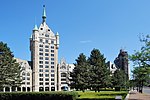Dunn Memorial Bridge
1969 establishments in New York (state)Bridges completed in 1969Bridges in Albany County, New YorkBridges in Rensselaer County, New YorkBridges of the United States Numbered Highway System ... and 10 more
Bridges over the Hudson RiverBuildings and structures in Albany, New YorkGirder bridges in the United StatesMonuments and memorials in New York (state)Road bridges in New York (state)Steel bridges in the United StatesTransportation in Albany, New YorkU.S. Route 20U.S. Route 9Unfinished buildings and structures in the United States
The Dunn Memorial Bridge, officially known as the Private Parker F. Dunn Memorial Bridge, carries US 9 and US 20 across the Hudson River between Albany, New York and Rensselaer, New York.
Excerpt from the Wikipedia article Dunn Memorial Bridge (License: CC BY-SA 3.0, Authors).Dunn Memorial Bridge
Dunn Memorial Bridge,
Geographical coordinates (GPS) Address Nearby Places Show on map
Geographical coordinates (GPS)
| Latitude | Longitude |
|---|---|
| N 42.643136 ° | E -73.747551 ° |
Address
Dunn Memorial Bridge
Dunn Memorial Bridge
12246
New York, United States
Open on Google Maps








